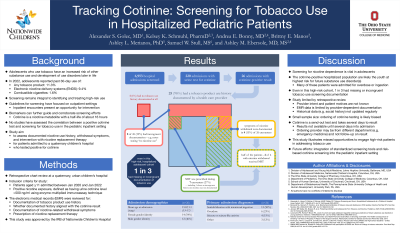Back

(98) Tracking Cotinine: Screening for Tobacco Use in Hospitalized Pediatric Patients
Saturday, April 6, 2024
9:45 AM – 1:15 PM


Alexander S. Golec, MD, FAAP, FASAM
Assistant Professor of Pediatrics
Johns Hopkins University, Maryland
Ashley M. Ebersole, MD, MS, FAAP
Assistant Professor of Clinical Pediatrics
The Ohio State University and Nationwide Children's Hospital, Ohio
Presenter(s)
Non-presenting author(s)
Background & Introduction: Tobacco use remains the leading cause of morbidity and mortality in the United States [1]. Despite a historically low combustible cigarette smoking prevalence of 1.6% among adolescents in 2022, electronic nicotine delivery systems (ENDS) remained the most commonly reported tobacco product with 9.4% reporting past 30-day use [2]. ENDS pose significant health concerns and increase risk of future cigarette use despite adolescents’ perceptions of lower risk [3].
The last decade has seen an increased focus on identifying and treating high-risk substance use. Screening for tobacco use, including ENDS use, remains integral to this goal [1]. However, guidelines for screening have largely focused on outpatient settings [4]. Inpatient hospital encounters present an opportunity for intervention. Prior research has shown that screening for tobacco use in pediatric hospital encounters was infrequent and not standardized [5].
Biomarkers can further guide and corroborate screening efforts. Specifically, cotinine is a widely used nicotine metabolite that can be measured in patients’ urine to determine nicotine exposure. To date, no studies have assessed the correlation between a positive cotinine test and screening for tobacco use in the pediatric inpatient setting.
Methods: This was a retrospective chart review of patients admitted to a quaternary, urban children’s hospital between January 2020 and January 2022. Inclusion criteria were age ≥11 years and positive nicotine exposure, defined as having urine cotinine levels >500 ng/ml using enzyme-multiplied immunoassay technique. The hospital admission associated with the positive urine cotinine finding was reviewed by two individuals. If needed, an arbitrator was available to settle discrepancies. This study was approved by the hospital’s institutional review board.
The electronic medical records (EMRs) of eligible patients were reviewed for documentation of tobacco product use history and whether this history aligned with the present cotinine results. Documentation of nicotine-related withdrawal symptoms and prescription of NRT was also abstracted from the EMR.
Descriptive statistics included count (percentage) for categorical variables and mean (standard deviation) for continuous variables.
Results: A total of 6,953 hospital admissions were screened. There were 220 admissions during which the patient was tested for cotinine, resulting in 26 positive results (11.8%). These 26 hospital encounters represented 25 unique patients over this 2-year period.
Of these 26 hospital encounters, 25 (96.2%) had a tobacco product use history documented by any health care provider. However, 8 (30.8%) encounters had incongruent documentation i.e. documentation of nicotine use stated “no use”. Signs of nicotine withdrawal were documented in 4 (15.4%) of these 26 encounters, and NRT was prescribed during 7 encounters (26.9%). Among the four patients with documented nicotine withdrawal, 2 (50.0%) were prescribed NRT.
Conclusion & Discussion: The pediatric inpatient setting is a missed opportunity for nicotine use screening and intervention. The cotinine-positive hospitalized population represents perhaps the youth at highest risk for substance use disorders, as many of these patients were admitted for overdose or ingestion. Screening and treating nicotine dependence is vital in adolescents because not only does nicotine use have many health consequences, but use in adolescents also increases the risk of other substance use later in life.
This study is limited by retrospective review, and thus provider intent and patient motives are not known. The data from the EMR is limited by provider-dependent documentation, and historical data that is not updated regularly. Ordering of cotinine testing is likely biased based on patient presentation at admission and resulted in a small sample size. Additionally, cotinine detection is a send-out test, and takes several days to result, so results are often not known to influence provider assessment at admission.
This study illustrates missed opportunities to engage at-risk patients in addressing tobacco use. Integration of standardized screening tools and risk-based cotinine screening into the pediatric inpatient setting may help trigger further assessment to link patients to care and should be the focus of future efforts.
References: 1. Health. The Health Consequences of Smoking—50 Years of Progress: A Report of the Surgeon General. Centers for Disease Control and Prevention (US); 2014. Accessed June 28, 2023. https://www.ncbi.nlm.nih.gov/books/NBK179276/
2. Park-Lee E, Ren C, Cooper M, Cornelius M, Jamal A, Cullen KA. Tobacco Product Use Among Middle and High School Students - United States, 2022. MMWR Morb Mortal Wkly Rep. 2022;71(45):1429-1435. doi:10.15585/mmwr.mm7145a1
3. Walker MW, Navarro M, Roditis M, Dineva AN. Adolescent risk perceptions of ENDS use: Room for change in tobacco education. Prev Med Rep. 2022;26:101719. doi:10.1016/j.pmedr.2022.101719
4. Jenssen BP, Walley SC, Boykan R, et al. Protecting Children and Adolescents From Tobacco and Nicotine. Pediatrics. 2023;151(5):e2023061804. doi:10.1542/peds.2023-061804
5. Alexander A, Honan R, Molina A, Rahman AKMF, Walley SC. Tobacco Screening and Use in Hospitalized Adolescents at a Children’s Hospital. Hosp Pediatr. 2021;11(6):605-612. doi:10.1542/hpeds.2020-002311
The last decade has seen an increased focus on identifying and treating high-risk substance use. Screening for tobacco use, including ENDS use, remains integral to this goal [1]. However, guidelines for screening have largely focused on outpatient settings [4]. Inpatient hospital encounters present an opportunity for intervention. Prior research has shown that screening for tobacco use in pediatric hospital encounters was infrequent and not standardized [5].
Biomarkers can further guide and corroborate screening efforts. Specifically, cotinine is a widely used nicotine metabolite that can be measured in patients’ urine to determine nicotine exposure. To date, no studies have assessed the correlation between a positive cotinine test and screening for tobacco use in the pediatric inpatient setting.
Methods: This was a retrospective chart review of patients admitted to a quaternary, urban children’s hospital between January 2020 and January 2022. Inclusion criteria were age ≥11 years and positive nicotine exposure, defined as having urine cotinine levels >500 ng/ml using enzyme-multiplied immunoassay technique. The hospital admission associated with the positive urine cotinine finding was reviewed by two individuals. If needed, an arbitrator was available to settle discrepancies. This study was approved by the hospital’s institutional review board.
The electronic medical records (EMRs) of eligible patients were reviewed for documentation of tobacco product use history and whether this history aligned with the present cotinine results. Documentation of nicotine-related withdrawal symptoms and prescription of NRT was also abstracted from the EMR.
Descriptive statistics included count (percentage) for categorical variables and mean (standard deviation) for continuous variables.
Results: A total of 6,953 hospital admissions were screened. There were 220 admissions during which the patient was tested for cotinine, resulting in 26 positive results (11.8%). These 26 hospital encounters represented 25 unique patients over this 2-year period.
Of these 26 hospital encounters, 25 (96.2%) had a tobacco product use history documented by any health care provider. However, 8 (30.8%) encounters had incongruent documentation i.e. documentation of nicotine use stated “no use”. Signs of nicotine withdrawal were documented in 4 (15.4%) of these 26 encounters, and NRT was prescribed during 7 encounters (26.9%). Among the four patients with documented nicotine withdrawal, 2 (50.0%) were prescribed NRT.
Conclusion & Discussion: The pediatric inpatient setting is a missed opportunity for nicotine use screening and intervention. The cotinine-positive hospitalized population represents perhaps the youth at highest risk for substance use disorders, as many of these patients were admitted for overdose or ingestion. Screening and treating nicotine dependence is vital in adolescents because not only does nicotine use have many health consequences, but use in adolescents also increases the risk of other substance use later in life.
This study is limited by retrospective review, and thus provider intent and patient motives are not known. The data from the EMR is limited by provider-dependent documentation, and historical data that is not updated regularly. Ordering of cotinine testing is likely biased based on patient presentation at admission and resulted in a small sample size. Additionally, cotinine detection is a send-out test, and takes several days to result, so results are often not known to influence provider assessment at admission.
This study illustrates missed opportunities to engage at-risk patients in addressing tobacco use. Integration of standardized screening tools and risk-based cotinine screening into the pediatric inpatient setting may help trigger further assessment to link patients to care and should be the focus of future efforts.
References: 1. Health. The Health Consequences of Smoking—50 Years of Progress: A Report of the Surgeon General. Centers for Disease Control and Prevention (US); 2014. Accessed June 28, 2023. https://www.ncbi.nlm.nih.gov/books/NBK179276/
2. Park-Lee E, Ren C, Cooper M, Cornelius M, Jamal A, Cullen KA. Tobacco Product Use Among Middle and High School Students - United States, 2022. MMWR Morb Mortal Wkly Rep. 2022;71(45):1429-1435. doi:10.15585/mmwr.mm7145a1
3. Walker MW, Navarro M, Roditis M, Dineva AN. Adolescent risk perceptions of ENDS use: Room for change in tobacco education. Prev Med Rep. 2022;26:101719. doi:10.1016/j.pmedr.2022.101719
4. Jenssen BP, Walley SC, Boykan R, et al. Protecting Children and Adolescents From Tobacco and Nicotine. Pediatrics. 2023;151(5):e2023061804. doi:10.1542/peds.2023-061804
5. Alexander A, Honan R, Molina A, Rahman AKMF, Walley SC. Tobacco Screening and Use in Hospitalized Adolescents at a Children’s Hospital. Hosp Pediatr. 2021;11(6):605-612. doi:10.1542/hpeds.2020-002311
Learning Objectives:
- Assess for opportunities for nicotine use screening and intervention in pediatric inpatient settings.
- Understand the potential use of cotinine as a screeing tool in pediatric inpatient settings.
- Recognize the opportunities to engage at-risk patients in addressing tobacco use.
